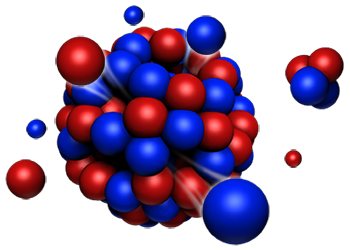Speaker
Description
Proportional Technologies, Inc. has previously developed a neutron imaging detector, based on boron-coated straws (BCS), a technology aimed to replace 3He tubes in large-scale neutron science instruments, like the Cold Neutron Chopper Spectrometer (CNCS) at the SNS (ORNL). That detector is composed of 1" tubes, each containing 7 straws. Each straw is 7.5 mm in diameter, and 1 m in active length, coated on the inside with 10B-enriched boron carbide (10B4C). We are currently providing tubes of this design to the ISIS (UK) group. Use of these tubes for the full implementation of the LoKI instrument at ESS is far along in the development path. In order to improve efficiency of our 1" tubes, we have now developed a modified BCS design with inner coated walls (septa) formed inside each straw. The outer straw diameter remains the same (7.5 mm), but the inner septa increase the coated wall area by 3 times. Prototypes with 12 septa (“Pie12”) have been manufactured and tested. The thermal neutron detection efficiency for only 2 layers of the Pie12 7-pack is 57%, which is higher than that of 5 layers of the original round straws which have 53% efficiency. Using the planned four layers of modules efficiency can be improved to 68%.
In order to address requirements for high resolution instruments we present a totally new configuration based on rectangular channels. Small single crystal diffractometers, for instance, require 0.3-0.6 mm resolution, and neutron reflectometers require 1-2 mm. Other requirements include high rate, and excellent gamma rejection. The proposed structure satisfies the above in a close-packed array of rectangular channels, sealed inside a thin walled aluminum, laser-welded enclosure. Each channel is fabricated by squashing a round BCS into a rectangular shape, lined on the four inner faces with 10B4C. The BCS straw material is highly resilient to mechanical distortions without loss in coating adhesion, as demonstrated in the pie shapes that are being produced in large volume for military applications. In this fabrication inner septa are fabricated by collapsing a section of the coated wall onto itself, forming a rigid septum of only 50 μm thickness. The squashed straw array (SSA) proposed can be configured with any desired channel dimensions. Prototypes with 1x5 mm2 and 0.5x2.5 mm2 channels have been constructed and thoroughly tested. A ratio of 1-to-5 is optimal for adequate collection of ionization, while minimizing the number of channels in the direction of the neutron beam. The smaller SSA can achieve a resolution of 0.5 mm, and a thermal neutron efficiency of 50% in only 2 layers, and 68% in 5 layers. The design yields excellent gamma rejection and very low scattering material consisting of only thin (25 μm) Al foil contributing only 84 mg/cm2 Al per layer.
Finally, we present the design and performance of an electronic readout for resistive charge division capable of supporting very much higher rates than have been achievable with high pressure 3He. The design is based on a simple 2-transistor amplifier with tail cancellation and a 1.5-GHz following operational amplifier. It is shown to produce a neutron signal with a rise time of 15 ns. Using a positive ion cancelation circuit a fall time of 70 ns is achieved, producing a signal width that is more than 4 times faster than previous electronics tested at SNS. We expect the new readout will demonstrate the ability of straw detectors to generate a digitized rate exceeding 1 MHz using a streaming digitizer. Together with PTI’s large scale 10B4C foil coating capability these developments are expected to effectively address many instruments at neutron sources around the world.

